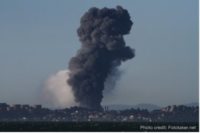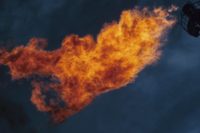CSB to investigate Chevron refinery fire

 The U.S. Chemical Safety Board (CSB) has decided to pursue a full investigation to determine the causes of last week’s fire at the Chevron oil refinery in Richmond, California, northeast of San Francisco.
The U.S. Chemical Safety Board (CSB) has decided to pursue a full investigation to determine the causes of last week’s fire at the Chevron oil refinery in Richmond, California, northeast of San Francisco.
A CSB team numbering seven investigators arrived in at the refinery on Wednesday and has since been conducting witness interviews and reviewing documents at the site. CSB structural and industrial safety experts will reach the site today Monday to prepare for safe entry by investigators into the immediate area of the fire.
A gas-oil leak
The fire occurred when a combustible hydrocarbon liquid known as “gas-oil” leaked from an eight-inch pipe connected to a crude oil distillation tower in the refinery’s crude unit. Workers initially noted the leak and were in the process of attempting repairs on piping connected to the still-operating crude oil distillation tower when the leak suddenly intensified. Due to the high temperature of the material in the tower (in excess of 600 degrees Fahrenheit) the gas-oil immediately formed a large flammable vapor cloud.
“Witness testimony collected by CSB investigators indicates that a large number of workers were engulfed in the vapor cloud,” said CSB Team Lead Dan Tillema, P.E. “These workers might have been killed or severely injured, had they not escaped the cloud as the release rate escalated and the cloud ignited, shortly thereafter.”
Most serious U.S. refinery incident in recent years
CSB Chairperson Dr. Rafael Moure-Eraso said: “Monday’s fire was a near-disaster for refinery personnel. The circumstances warrant a full and independent federal investigation to determine the root causes. Although fortunately no workers were killed, the overall impact of the incident ranks it as among the most serious U.S. refinery incidents in recent years.”
“The information gathered so far indicates the incident had a serious impact on the community,” said CSB Board Member Mark Griffon, accompanying the team. “Area hospitals told CSB investigators that they attribute hundreds of emergency room visits by community members to reported effects of the release and fire, with symptoms ranging from anxiety to respiratory distress.”
Mr. Tillema said important issues in the investigation included understanding why the pipe that later failed was kept in service during a late 2011 maintenance turnaround and what procedures and industry practices exist for responding to a leak of combustible material from a running unit. He said the Board anticipates executing a site preservation and evidence testing agreement with Chevron and other investigative groups and arranging for independent testing of the leaking section of pipe to determine the failure mechanism.
Chevron, USW, CAl/OSHA, EPA involved
Both Chevron and the United Steelworkers, which represents hourly workers at the plant, have been cooperating with the CSB team. Chevron has provided assurances its personnel will freely share their knowledge and investigative information with the Board. Cal/OSHA, Contra Costa County, the EPA, and other investigative groups are fully cooperating.
The CSB is an independent federal agency charged with investigating serious chemical accidents. The agency's board members are appointed by the president and confirmed by the Senate. CSB investigations look into all aspects of chemical accidents, including physical causes such as equipment failure as well as inadequacies in regulations, industry standards, and safety management systems. Please visit the CSB’s website at www.csb.gov.
Looking for a reprint of this article?
From high-res PDFs to custom plaques, order your copy today!




